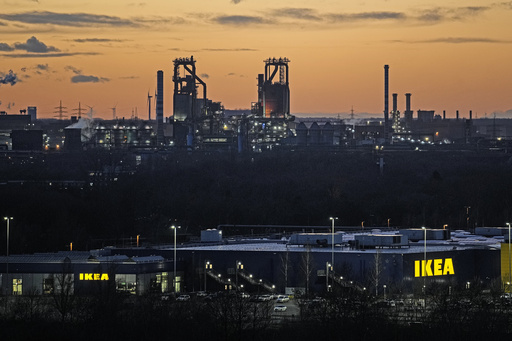
FRANKFURT, Germany — Significant economic growth has eluded Germany for the past five years, marking a dramatic change for the largest economy in Europe. Historically renowned for its export-driven economy, particularly in high-quality manufactured goods like industrial machinery and luxury automobiles, Germany now faces continued economic decline.
So, what led to this downturn? Here are five key factors contributing to Germany’s persistent economic challenges:
**Energy Disruption from Russia**
The halt of natural gas supplies from Russia, following the invasion of Ukraine, has struck a heavy blow to Germany’s economy. For a significant period, Germany’s energy strategy was centered around affordable energy to support its industrial sector. In 2011, former Chancellor Angela Merkel expedited the closure of nuclear power plants while anticipating that Russian gas would help transition the country away from coal towards renewable sources. Despite early warnings from nations such as Poland and the U.S., Germany relied heavily on Russian energy imports.
When these supplies were cut, the costs for gas and gas-generated electricity surged, directly impacting industries reliant on energy, like steel and chemical manufacturing. Consequently, Germany resorted to importing liquefied natural gas (LNG) from countries like Qatar and the U.S., which comes at a higher price than piped gas. The average price for electricity in Germany now stands at about 20.3 euro cents per kilowatt hour, whereas competitors in the U.S. and China enjoy rates around 8.4 euro cents. Attempts to scale renewable energy sources have not progressed quickly enough, and opposition from communities has impeded wind energy expansion. The necessary infrastructure for hydrogen fuel as an alternative for steel production remains largely in development.
**Evolving Dynamics with China**
Germany previously thrived due to China’s integration into the global economy, finding a lucrative market for its industrial products. Major car manufacturers like Volkswagen, BMW, and Mercedes-Benz profited immensely as they tapped into what became the largest automobile market globally. Initially, Chinese industries focused on non-competitive sectors, but that has changed radically.
State-supported Chinese companies began producing the same products as their German counterparts, undermining Germany’s market position. Once dependent on German technology for solar panel production, China has now established itself as the dominant player in the global solar market. With the Chinese government’s initiatives promoting manufacturing beyond traditional goods, sectors like electric vehicles and machinery now directly compete with German exports. China’s automotive export capacity has surged, and its ability to produce 50 million vehicles annually significantly impacts Germany’s own shrinking export rate.
**Underinvestment in Infrastructure**
In times of prosperity, Germany prioritized balancing the budget over investing in critical infrastructure projects. This delay has resulted in a deterioration of public services. Current challenges include unreliable train systems struggling with maintenance and a lack of high-speed internet access in rural regions. Infrastructure projects like vital electricity transmission lines have lagged, and road integrity issues have forced closures of key bridges, further complicating industrial logistics. A 2009 reform limiting government deficit spending restricts potential government-led investment strategies, posing future challenges for the newly formed government post-February election.
**Shortage of Skilled Workers**
The labor market in Germany is facing a significant skills gap, hindering various sectors, from tech to hospitality. A survey conducted by the German Chamber of Commerce revealed that 43% of enterprises struggled to fill vacancies, a problem that becomes more pronounced in larger companies, rising to 58%.
The declining interest of students in STEM (Science, Technology, Engineering, and Mathematics) fields is exacerbated by an aging workforce and a shortage of affordable childcare, limiting many women’s ability to work full-time. Although recent legislative changes aim to facilitate the hiring of skilled immigrants, bureaucratic hurdles continue to pose significant challenges to addressing these labor shortages.
**Bureaucratic Barriers**
The German economy grapples with cumbersome bureaucracy, which is a significant impediment to efficiency. For instance, obtaining a permit to erect a wind turbine may stretch out over several years. Furthermore, businesses face redundant processes, such as restaurants needing to log refrigerator temperatures manually despite having digital records. New regulations requiring businesses to ensure their suppliers comply with environmental and labor laws add additional burdens, often surpassing EU requirements and hampering competitiveness.
As Germany navigates these growing economic challenges, the path to recovery will require reevaluating existing policies and the long-term health of its industrial sector.

